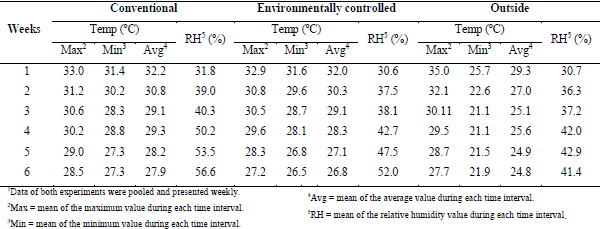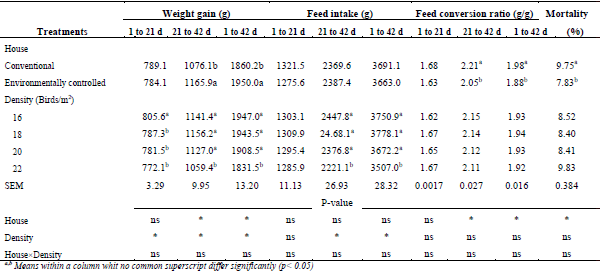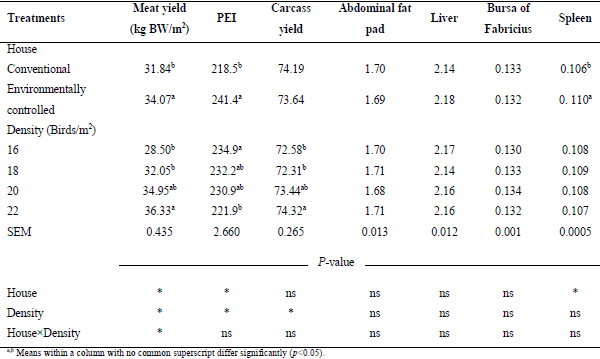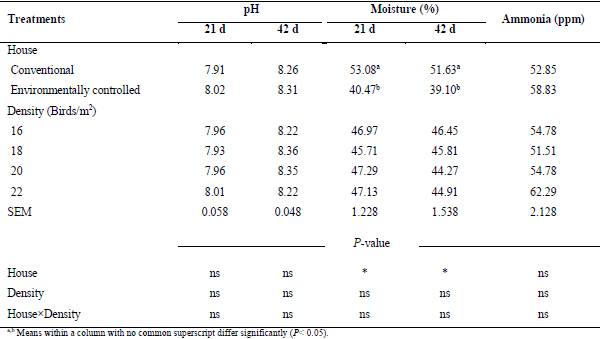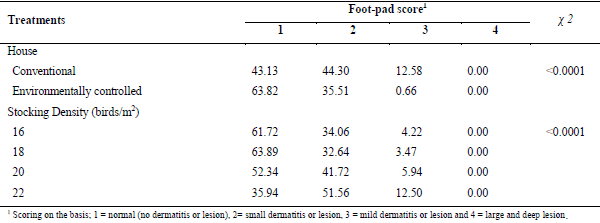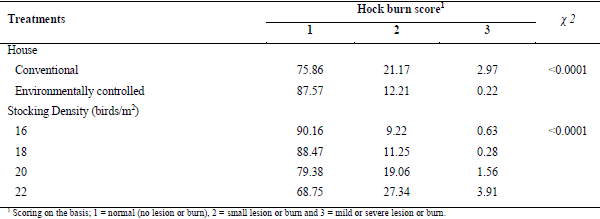Introduction
Many parameters such as temperature and humidity affect environmental conditions within a poultry house. Heat and cold stresses, wet litter and ammonia emissions are among the extreme conditions adversely affecting the poultry performance (Al-Homidan et al., 2003). The two later factors are associated with another factor termed stocking density as a debating issue in intensive poultry production (Dozier et al., 2006; Estevez, 2007). Increasing stocking density is an important management practice taken by the growers to reduce the costs of poultry production (Feddes et al., 2002; Estevez, 2007). Broiler production at higher stocking density may lead to deleterious effects on environmental condition within the house and hence, negatively affect poultry welfare, health and performance (Dozier et al., 2005a, b).
On the other hand, uncontrolled environmental conditions of a house intensify deleterious effects of higher stocking density on poultry (Dawkins et al., 2004; Estevez, 2007). The consequence of increasing stocking density on environmental conditions within a poultry house includes changes in the microclimate quality of the birds such as creation of wet litter and ammonia emissions (Estevez, 2007). Increasing stocking density must be adjusted according to house environmental conditions, equipment, ventilation system, drinker and feeder space, etc. Otherwise, it may have deleterious effects on birds and negatively influence growth performance as well (Estevez, 2007; Yardimci & Kenar, 2008). It means that increasing the stocking density in an environmentally controlled house can have less negative effect on house environment and poultry performance than a conventional house as long as appropriate environmental conditions can be maintained (Yardimci & Kenar, 2008). Dawkins et al. (2004) suggested that environmental conditions of a poultry house and litter quality had a more direct impact on broiler production and welfare than stocking density.
An alternative to increasing the broiler production per unit area is using environmentally controlled houses (Czarick & Lacy, 1990; Puron et al., 1997). A house with suitable construction insulation, ventilation design and environmental control system provide the possibility of broiler rearing at higher density (Puron et al., 1997; Estevez, 2007). Since the control of environment of the modern poultry is continuous and highly important, therefore, the aim of this study was to evaluate the possibility of increasing broiler density in an environmentally controlled house in comparison with a conventional house on broiler performance.
Materials and Methods
Housing and experimental treatments
This study was conducted in a commercial broiler farm where a conventional and an environmentally controlled house existed side by side. The housing capacity of conventional (12 × 50 m) and environmentally controlled (16 × 65 m) houses were 9,600 and 20,800 birds, respectively. Sidewalls of the conventional and environmentally controlled houses were made from brick (R-value 3.2, 32 cm thickness) and sandwich panel polyurethane (R-value 7, 5 cm thickness), respectively. The ceiling type of the conventional and environmentally controlled house was usual (brick housing, R-value 6) and hangar (polyurethane and glass wool insulation + galvanized sheet, R-value 15), respectively. Ventilation system design in the conventional (maximum ventilating capacity 339,000 m3/h) and the environmentally controlled house (maximum ventilating capacity 187,500 m3/h) were cross ventilation (using windows and exhaust fans mounted on the opposed sidewalls) and intelligence system (combination of tunnel, transversal and minimum ventilation), respectively. Evaporative cooling system in the conventional house was traditional (by wetting the water cooler wood chips placed behind the windows) and in the environmentally controlled house, cooling pad system along with fogging nozzles was applied. Two continuous 42-day experiment periods were conducted using a total of 10,232 one-day-old straight-run broiler chickens (Ross 308) in both houses.
In each house, 16 floor pens were allocated to place the broilers. The pens arranged in the center of both houses and to simulate actual conditions, the pens were surrounded by a commercial broiler chicken flock composed of birds of the same origin as those used in the experiments. In each of two experiments, a total of 5,116 broiler chickens purchased from a commercial hatchery and were randomly distributed into prepared floor pens at different densities of 16, 18, 20 and 22 birds/m2 of floor space. Pens dimensions in conventional and environmentally controlled houses were 2.75×3 (8.25 m2) and 2.5×3.44 (8.60 m2), respectively. Height of the pens was 0.65 m. Each pen was covered with fresh wood shaving as litter material at about 5 cm depth. All pens at each density treatment had equal feeding and drinking equipment, which equipped with 13 nipple drinkers and two tube feeders.
The feeding spaces in each pen per densities of 16, 18, 20 and 22 birds/m2 were 2.37, 2.10, 1.89 and 1.72 cm/bird, respectively. The numbers of broiler chickens per each density treatment (during two 42-day experiments) in environmentally controlled and conventional houses, respectively were as follows: 1) a stocking density of 16 birds/m2: 548 and 528 birds/treatment (137 and 132 birds/pen), 2) a stocking density of 18 birds/m2: 620 and 592 birds/treatment (155 and 148 birds/pen), 3) a stocking density of 20 birds/m2: 688 and 660 birds/treatment (172 and 165 birds/pen) and 4) a stocking density of 22 birds/m2: 756 and 724 birds/treatment (189 and 181 birds/pen). Each density treatment was replicated four times.
Broiler chicken management
All broiler chickens were fed with a corn-soybean meal diet during 1 to 42 days of age which formulated to meet nutritional requirements of broilers according to NRC (1994) broiler recommendation. The composition of experimental diets and their nutritive characteristics are presented in Table 1. Average dry bulb temperature and relative humidity of outside and inside of the houses were recorded weekly during both experiments (Table 2).
Table 1. Composition and calculated analysis of diets in the experiments
Table 2. Temperature and relative humidity (RH) values of broiler houses during the study1
All diets were provided in mash form and feed and water were provided ad libitum throughout the experimental period. Lighting schedule was continuous in the first two days, and afterward, a 23L: 1D lighting schedule was applied. House temperature was maintained at 32 °C at the beginning of the experiments and thereafter reduced to about 22 °C at 24 day of period and maintained until 42 days of age.
Husbandry management in both houses was identical. The conditions and standards of rearing used in this research were approved by the Ethics Committee for Animal Experiments of the Animal Science Research Institute of Iran.
Measurements
The live body weight gain (WG) of broiler chickens was measured during 1 to 21, 21 to 42 and 1 to 42 days of age and feed intake was recorded in the aforementioned periods. Feed conversion ratio (FCR) was calculated after adjusting for the body weight (BW) of dead birds. At 42 days of age, kilograms of live broiler chickens per square meter (kg BW/m2) were calculated as total BW of birds in a pen divided by size of pen area (meter) (Puron et al., 1997). Production efficiency index (PEI) was determined according to below equation after calculating liability percentage (Liability % = 100 – Mortality %) and feed conversion ratio:

At day 42, four birds (2 male and 2 female) which represented an average pen weight were randomly selected from each pen, then they were weighed and slaughtered. The carcass without giblets was weighed and expressed as a percentage of its initial live weight and considered as the carcass yield. Also the weights of different gastrointestinal organs including abdominal fat pad, liver without bladder-gall, spleen and bursa of Fabricius were recorded and expressed as their relative weights to the live weight of each chicken.
At 21 and 42 days of age, litter samples were collected from the same locations of each pen for determination of pH (1:10 litter per distillated water) and moisture content (at 105°C for 24 h). Each litter sample consisted of six litter subsamples that were collected away from drinking and feeding equipment. At day 42, the ammonia emission from litter was determined by the method of Chamblee & Yeatman (2003). Briefly, after putting a 3.5 container fitted with a manual air-stirring device and an air-sampling port was inverted on the litter, after 5 min, an air sample was drawn into an ammonia detector tube (3La type, Gastec, Japan) by a manual pump (GV-100S, Gastec, Japan).
At 42 day of age, frequency of foot pad lesions and hock burns based on visible lesions or injuries were studied objectively on 40 randomly selected chickens (20 male and 20 female) from each pen using a 4-point scale (1 = no dermatitis or lesions, 2= small dermatitis or lesions, 3 = mild dermatitis or lesions and 4 = large and deep lesions) for footpad lesions and a 3-point scale (1 = no lesions or burns, 2 = small lesions or burns and 3 = mild or severe lesions or burns) for hock burns.
Statistical analysis
Data recorded from two experiments were pooled together for statistical analysis and were analyzed using the GLM procedure of SAS software (SAS, 1996) as a completely randomized block design in a 2×4 factorial arrangement of treatments with two house type and four stocking density (16, 18, 20 or 22 birds/m2) as main effects.
Significant differences among treatments were determined at a p<0.05 and the mean values were compared by Duncan’s multiple range tests. Pen was used as an experimental unit. Chi-square test was conducted for the data on the prevalence of foot pad dermatitis and hock burns, using frequency procedure of SAS (1996).
Results
Growth performance
The effect of house type and stocking density on broiler chickens performance during 1 to 21, 21 to 42 and 1 to 42 days of age are presented in Table 3. The WG of broiler chicken was not affected from house type and different stocking density during 1 to 21 days of age. However, during 21 to 42 and 1 to 42 days of age, the broiler chickens were grown in environmentally controlled house had greater (p<0.05) WG compared to those grown in the conventional house. During 1 to 21 days of age, the WG of broiler chicken decreased (p<0.05) as stocking density increased more than 16 birds/m2 and no difference was found in WG between densities of 18, 20 and 22 birds/m2. The broiler chickens grown at density of 22 birds/m2 had lower (p<0.05) WG than those grown at other densities during 21 to 42 and 1 to 42 days of age. Feed intake decreased (p<0.05) in broilers raised at the density of 22 birds/m2 compared to those grown at other densities and no difference was found in broiler chicken feed intake between other densities during 21 to 42 and 1 to 42 days of age. In the present study, FCR was not affected by stocking density (Table 3), though broiler chickens grown in the environmentally controlled house had lower (p<0.05) FCR compared to those grown in a conventional house during 21 to 42 and 1 to 42 days of age. At 42 days of age, the broiler chickens grown in the environmentally controlled house had lower (p<0.05) mortality percentage than those grown in a conventional house (Table 3), but mortality was not affected by stocking density.
Table 3. Effects of house type and varying stocking density on weight gain, feed intake and conversion ratio during 1to 21, 21 to 42 and 1 to 42 days of age and mortality percentage at 42 days of age in broiler chickens
There was no interaction effect between house type and stocking density on WG, feed intake, FCR, and mortality percentage at all days of age.
At day 42, the broiler chickens grown in the environmentally controlled house had greater (p<0.05) meat yield as kg of BW/m2 than those that were raised in a conventional house. The kg of BW/m2 increased (p<0.05) with increasing stocking density and resulted in significant (p<0.05) house type × stocking density interaction (Table 4). The nature of this interaction showed that increasing stocking density in the environmentally controlled house caused a maximum kg of BW/m2. The finding showed that PEI improved in broilers raised in the environmentally controlled house than a conventional house; however, increasing density adversely affected PEI.
Carcass characteristics
The results indicated that broiler chicken carcass yield was not affected by house type, though increasing stocking density from 16 to 22 bird/m2 increased (p<0.05) carcass yield at 42 days of age (Table 4). There was no interaction between house type and stocking density on carcass yield at 42 days of age. House type, stocking density and interaction between them had no significant influence on measured parameters (i.e. relative weight of liver, abdominal fat pad and bursa of Fabricius (Table 4).
However, the broiler chickens grown in the environmentally controlled house had greater (p<0.05) spleen relative weight compared to those grown in the conventional house.
Table 4. Effects of house type and varying stocking density on the meat yield as kg of BW per unit area, production efficiency index (PEI), carcass yield and relative weights of abdominal fat pad, liver, bursa of Fabricius and spleen in broiler chickens at 42 days of age
Litter quality
There was no effect of house type and stocking density and no interaction between them on litter pH at 21 and 42 days of age (Table 5). Litter moisture was higher (p<0.05) in the conventional house than environmentally controlled house at both 21 and 42 days of age. In the present study, stocking density had no effect on litter moisture. As shown in Table 5, ammonia emission from broiler litter was not affected by house type, stocking density and interaction between them at 42 days of age.
Table 5. Effects of house type and varying stocking density on broiler litter pH and moisture at 21 and 42 days of age and ammonia levels of broiler litter at 42 days of age
Foot lesions
At day 42, the broiler chickens grown in the environmentally controlled house had a greater normal foot pads and hocks (class 1) compared to those raised in the conventional house (Table 6 and 7). Increasing broiler density increased (p<0.05) the prevalence and severity of foot pad dermatitis and hock burns, as the broiler chickens grown at density of 22 birds/m2 had the greatest foot lesion scores when compared to those reared at lower densities.
Table 6. Effect of house type and varying stocking density on foot-pad dermatitis or lesion scores based on percentage of broiler chickens in each class at 42 days of age
Table 7. Effect of house type and varying stocking density on hock burn scores based on percentage of broiler chickens in each class at 42 days of age
Discussion
As this study was conducted in large scale experiment in a commercial farm with two conventional and environmentally controlled houses, undoubtedly, several other factors in the poultry houses such as housing dimensions, isolation (R-value), ventilation rate, lighting intensity and overall parameters that their estimate was not thoroughly possible, might have a role in the broiler production performance. As shown in Table 2, lack of a substantial difference between the measured temperature and relative humidity of ambient and inside of the houses, caused a little difference in environmental conditions of the houses, however, the average and the maximum temperatures of the environmentally controlled house were slightly lower than the conventional house during the two last weeks of each period. In the present study, increasing stocking density decreased WG of broiler chickens which were in agreement with those of other researchers, who reported less WG as stocking density increased for broiler chickens (Feddes et al., 2002; Dozier et al., 2005a,b; Dozier et al., 2006; Benyi et al., 2015). The improved performance of broilers raised in the environmentally controlled house was associated with better environmental conditions (Lacy & Czarick, 1992; Puron et al., 1997; Estevez, 2007). At 21 days of age, lack of difference among different density treatments on feed intake was in agreement with those of Dozier et al. (2006). However, decrease in feed intake during 21 to 42 and 1 to 42 days of age was in agreement with those of previous investigators, who attributed it to inhibited access to feeder space by increasing stocking density (Dozier et al., 2005b; Estevez, 2007). In the present study, similar to other studies (Feddes et al., 2002; Zhang et al., 2011), feeder and drinker spaces were equal in all density treatments. However, in some studies, feeding and drinking spaces per birds under high densities were increased through increasing the number of feeders and drinkers (Dozier et al., 2005b, Dozier et al., 2006). Zuowei et al. (2011) showed that adequate feeder space can be helpful for supporting enough feed intake of broiler chickens in high stocking density, while Hansen & Becker (1960) found that even with maintaining constant feeding space per bird, the negative effects of higher stocking density on birds has still existed. Feddes et al. (2002) reported that increasing the nipple drinkers from 5 to 20 numbers per pen had no effect on performance of broilers raised at high stocking density. They concluded that each nipple drinker was enough for each 20 broiler chickens to 2 kg body weight. In the present study, all pens in each house were equipped with 13 nipple drinkers which served to 10 to 14 birds per nipple for densities of 16 to 22 birds/m2, respectively. These nipple numbers are in the range of those of Feddes et al. (2002), that it seems there was not a shortage in drinking space among the broilers reared in varying stocking density. In contrast, it seems that the presence of only two tube feeders per pen partly decreased the feeding space in densities of 20 or 22 birds/m2. On the other hand, providing more feeding or drinking space through increasing feeder or drinker devices may intensify the negative effects of high stocking density on chickens, mainly due to decreased available floor space of pens and thereby decreased movement ability of chickens and increased stress among chickens (Estevez, 2007). It has been reported that stocking density has shown no effect on FCR (Feddes et al., 2002; Skeroglu et al., 2011), which was confirmed in this study. In agreement with this result, some investigators indicated that stocking density had no effect on mortality rate (Feddes et al., 2002; Skeroglu et al., 2011). It is well established that growth rate of chickens decreases by increasing stocking density, however, it may achieve maximum return per square meter of floor space (Puron et al., 1995). Broiler rearing in the environmentally controlled house led to improvement in the produced meat yield as kg of BW/m2 compared to conventional house. Moreover, kg of BW/m2 increased by increasing stocking density. Improved meat yield per floor space in environmentally controlled house was mainly related to better environmental conditions for broiler chickens, so that the greater WG and lower mortality rate caused a greater meat yield as kg BW/m2 in broilers reared in higher stocking density.In this study, increasing stocking density increased carcass yield, but had no effect on the relative weight of giblets. In contrast, Bilgili &Hess (1995) and Dozier et al. (2006) indicated that stocking density had no effect on carcass yield in broiler chickens. Previous studies by some researchers showed that stocking density had no effect on carcass relative weight of giblets in broiler chickens (Turkyilmaz, 2008; Buijs et al., 2009; Jayalakshmi et al., 2009). However, Heckert et al. (2002) demonstrated that relative weight of bursa of Fabricius decreased as stocking density increased from 10 to 20 broilers/m2. The greater relative weight of spleen in broiler chickens grown in environmentally controlled house was presumably due to improved immune system subsequent better air quality of the house and proper ventilation (Czarick & Lacy, 1990; Estevez, 2007).The house type and varying stocking density had no effect on litter pH. It is shown that litter pH is one of the important factors in ammonia emission in poultry houses (Coufal et al., 2006), however, it seems that litter pH is less affected by stocking density (Zhang et al., 2011). Litter moisture is a substantial factor in the ammonia emission in poultry houses (Al-Homidan et al., 2003). Improved environmental conditions through proper ventilation and appropriate structure insulation resulted in less litter moisture content within environmentally controlled house compared to conventional house. Litter moisture was not affected by varying stocking density. In contrast, Dozier et al. (2005b) showed that litter moisture increased as stocking density increased. The litter ammonia level was not affected by house type and also, did not differ among density treatments. This finding is in agreement with those of Dozier et al. (2005b), who found that stocking density had no effect on litter ammonia emission mainly because of the increased caked litter in the pens, which had presumably suppressed ammonia emission.The foot lesions in broiler chickens are an animal welfare issue because these lesions cause serious discomfort to chickens. In this regard, more emphasis has been laid on litter moisture content (Meluzzi et al., 2008). Control of environmental conditions, particularly through litter quality is an important key issue to improve the broiler welfare by reducing foot lesions. Lower incidence and severity of foot pad dermatitis and hock burns in broiler chickens grown in environmentally controlled house was mainly associated with lower litter moisture content due to better controlling of environmental conditions and proper ventilation than a conventional house. Bilgili et al. (2010) reported that wet and caked litter was a primary cause in greater incidence of foot pad dermatitis and hock burns and proper ventilation was a key factor for decreasing wet litter. In the present study, although litter moisture was not affected by increasing stocking density, however, its content in all pens was high enough to affect foot pads and hocks. Ventura et al. (2010) reported that the prevalence of foot lesions increased as broiler density increased. Higher stocking density often makes an unsuitable rearing situation by deteriorating environmental conditions within a poultry house (Dozier et al., 2006; Estevez, 2007). In general, it seems that rearing the broilers at higher density in environmentally controlled conditions resulted in better foot health than a conventional house.
Conclusions
In conclusion, the broiler chickens reared in the environmentally controlled house had superior performance, higher liability and PEI, lower litter moisture content, and foot lesions compared to those grown in the conventional house. Rearing broiler chickens at stocking density higher than 20 birds/m2, compared to those grown at lower densities, adversely affected growth performance, PEI and foot quality, despite the greater kg of produced BW/m2.
This article was originally published in Journal of BioScience and Biotechnology, 2016, 5(1): 69-78. This is an Open Access article distributed under the Creative Commons Attribution License. 
